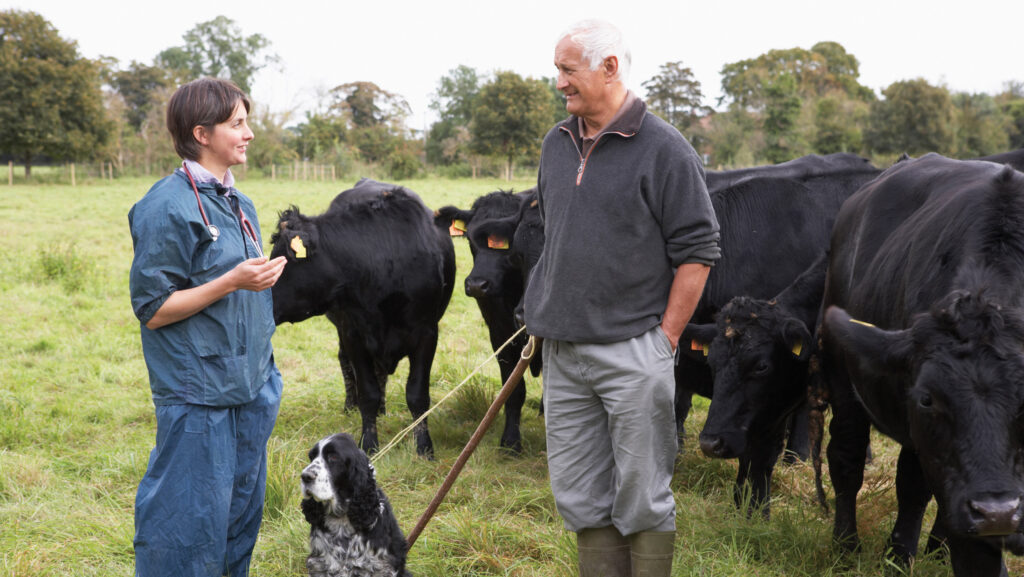Advice on how to make the most of your farm vet
 © Adobe Stock
© Adobe Stock We are all familiar with the traditional and “proper” work of the farm animal veterinary surgeon: the long glove, the calving jack, the cups of coffee at an annual review.
Clients will regale us with stories – oddly repeatable and always unverifiable – of the retired partner who notched up 10 calvings in a day, resurrected a dying calf just as it was gasping its last, or pregnancy-diagnosed 300 cows during a blizzard.
This work, both cow-side and in the office, will remain the bulk of what we do as vets. However, farms can leverage the network, experience and scope of their veterinary practice in different ways.
See also: What farmers can gain from a vet discussion group
About the author
 Kaz Strycharczyk is a vet at Black Sheep Farm Health.
Kaz Strycharczyk is a vet at Black Sheep Farm Health.
Here he explains how vets can help farmers beyond their traditional role, from bespoke training to assistance with grant applications.
Speaking selfishly, this adds interest to our traditional role and can trigger a novel income stream.
Importantly, it makes us better practitioners by imparting a more well-rounded view of our clients’ farming enterprises.
The following are some of the ways clients have used our practice. If farmers have an idea, I would encourage them to at least ask their vet if they would consider it.
The worst they are likely to get is a polite “not for now”.
Tailored training
Training is underrated and too often seen as a case of “getting your ticket” to satisfy an auditor. Contrast that with most professions, where continuing professional development is a cornerstone.
Most practices will offer some training to farmers.
The topics are often aimed at those relatively new to farming (for example, novice calving or lambing courses), or to fulfil a farm assurance requirement for, say, medicines handling.
These are definitely worthwhile, but ask yourself two questions:
- When was the last time I underwent training for my work on the farm when I wasn’t obliged to?
- If I was asked to spend a day a month training, with free choice on the topic(s), which would I choose?
Bespoke topics – an advanced lambing course, milking routine analysis, a body condition bootcamp – work well with medium-sized groups.
Sometimes this will be a group of farmers who club together, or the staff of one larger farm.
Likewise, training does not have to be delivered in a sit-down lecture environment. It might be a practical workshop, a facilitated discussion within a benchmarking group, or a “school trip”.
The latter can be local or further afield, and provides an opportunity to see different methods of production in action.
Supporting grant applications
The current Animal Health and Welfare Pathway understandably requires direct involvement with the farm vet. However, there are other opportunities to use them with other support schemes.
For example, the Farming Equipment and Technology Fund states that a conversation with the vet to discuss an application will give it a 20% uplift.
There are less obvious routes for involvement too.
For the newer Accelerating Development of Practices and Technologies funding, veterinary practices may be ideal partners to loop into animal health or welfare projects.
We have assisted one client with a Farming in Protected Landscapes application for a bracken cutter, with supporting material about tick-borne disease.
Another project in development is supporting a farm cluster.
Expenditure reviews
The services we provide and the products we sell result in an invoice being sent.
Just like most farms, veterinary practices are small or medium-sized businesses that aim to run at a profit – a fair and reasonable one.
No matter the economic climate, it is right that our clients interrogate all their costs. Their vets are here for a grown-up discussion about what farmers are paying for, and why.
This is a particular benefit of a locally owned practice – the farmer can have the ultimate decision-makers on-farm or on the phone within hours.
To inform this discussion, given a little notice, we can work out a client’s annual spend and divide it in several ways, for example:
- Reactive versus routine versus proactive
- Service versus product
- By species.
No vet wants to be in a position where their own best day is their client’s worst. Traditional reactive spend is a surefire way to get there, while proactive spend will guard against it.
Community participation
Farmers are typically active participants in their community.
Personally, I have been fed, watered, entertained, jump-started, pulled out of ditches, and otherwise rescued by clients. It is only right that we contribute as well.
Sponsoring the local rugby team, donating to a Young Farmers’ raffle, providing a speaker for a local farming cluster, advocating for our clients with government, or hosting a social barbecue; these are all small, enjoyable ways we can support our communities.
If support is needed for a cause or event, it’s worth dropping into the local practice, as they may well be able to help.
The critical friend
Although it is not common practice in UK agriculture, many other businesses bring in external advisers to sit on boards.
These boards are diverse in their makeup (businesspeople, lawyers, accountants) and meet periodically to assess the state of the business and assist with upcoming challenges.
Vets (especially business owners) navigate a lot of the same challenges, such as managing uncertainty, maintaining good working relationships, broaching difficult conversations, and working with economic necessity.
The reality is that these meetings already happen every day – one-to-one, informally, and often leaning over a gate.
The vet is already a trusted adviser and a “critical friend” who can volunteer constructive criticism and solutions.
If there is someone whose opinion the farmer values, it is well worth inviting them in with others to provide honest and supportive oversight.
